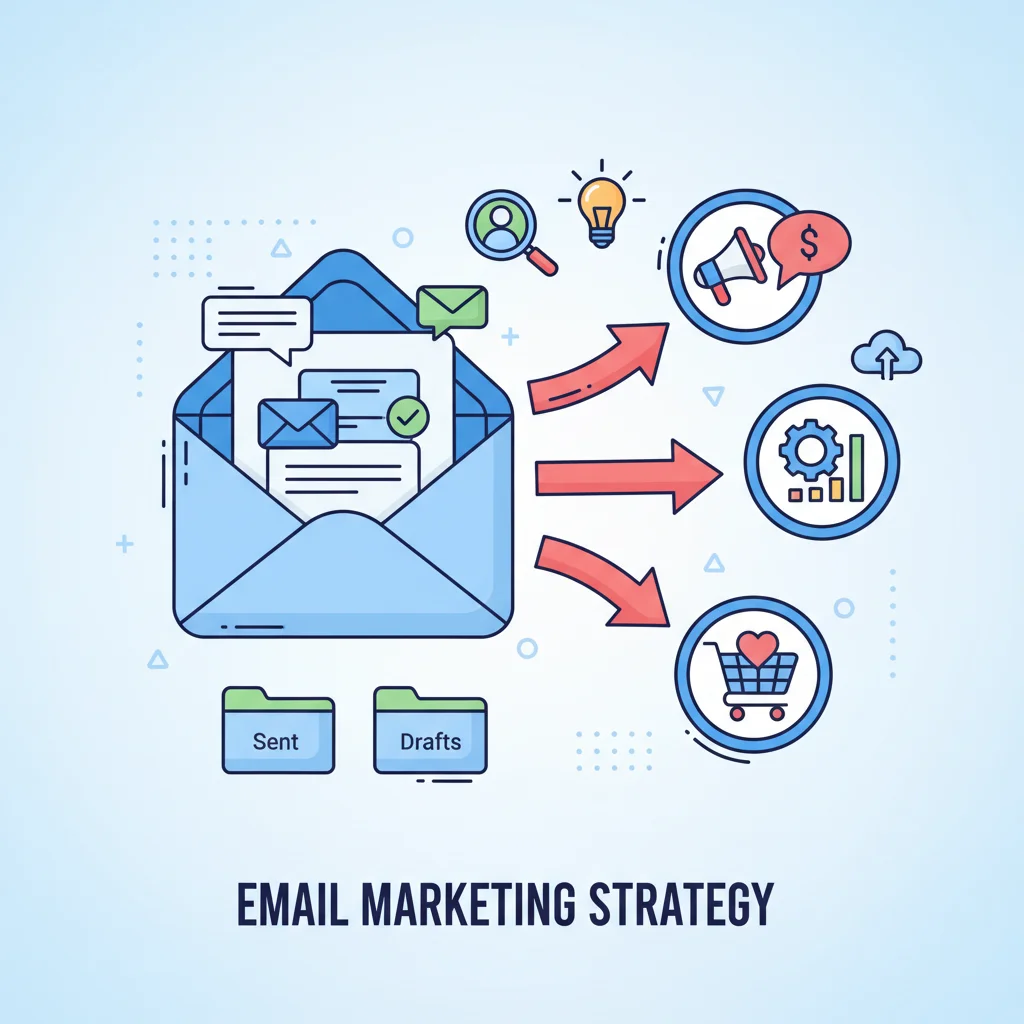Now Reading: Top 7 Important Email Marketing Metrics to Track Now
-
01
Top 7 Important Email Marketing Metrics to Track Now
Top 7 Important Email Marketing Metrics to Track Now

Are you still obsessing over open rates while your competitors are driving actual revenue from their email campaigns? If you’re nodding yes (or feeling slightly attacked), you’re not alone. Most marketers I work with are tracking the wrong metrics. Let’s cut through the noise and focus on the truly important email marketing metrics to track that will transform your email strategy from a cost center to a profit generator.
Key Takeaways
What are the most important email marketing metrics to track? Here’s what you need to know:
- Click-through rate (CTR) measures engagement and effectiveness of your calls-to-action
- Conversion rate tracks how many recipients completed your desired action
- Deliverability rate ensures your emails are actually reaching inboxes
- Revenue per recipient directly connects your email efforts to financial outcomes
- List growth rate indicates the health and expansion of your audience
- Bounce rate helps maintain list quality and sender reputation
- Unsubscribe rate signals content relevance and audience satisfaction
Click-Through Rate (CTR)
If I could track only one email metric, it would be click-through rate. CTR measures the percentage of recipients who clicked on a link within your email after opening it.
Why it matters: CTR is what I call the “day-to-day” metric because it lets you quickly calculate performance for every email you send. It’s the most direct indicator of whether your content resonates with your audience.
How to calculate it: Divide the number of unique clicks by the number of delivered emails, then multiply by 100.
CTR = (Number of unique clicks ÷ Number of delivered emails) × 100What’s a good CTR? It varies by industry, but generally:
- 2-5% is average
- Above 5% is good
- Above 10% is exceptional
How to improve your CTR:
- Test different CTA placements (I’ve found that having the first CTA above the fold typically increases clicks by 25%)
- Create a sense of urgency in your copy
- Optimize for mobile viewing
- Segment your audience for more relevant content
Conversion Rate
This is where the rubber meets the road. Conversion rate measures the percentage of recipients who completed your desired action after clicking a link in your email.
Why it matters: While CTR shows engagement, conversion rate shows effectiveness. This metric directly ties to your business goals, whether that’s making a purchase, signing up for a webinar, or downloading a resource.
How to calculate it: Divide the number of people who completed the desired action by the number of delivered emails, then multiply by 100.
Conversion Rate = (Number of conversions ÷ Number of delivered emails) × 100How to improve your conversion rate:
- Align your email content with your landing page for a seamless experience
- Reduce friction in the conversion process
- Use clear, benefit-focused CTAs
- Test different offers and incentives
Useful Articles:
Deliverability Rate
Before anyone can open, click, or convert, your email needs to actually reach their inbox. Deliverability rate measures the percentage of emails that made it to recipients’ inboxes versus those that bounced or went to spam.
Why it matters: Low deliverability means all your other metrics are based on a smaller audience than intended. It’s also an early warning sign of potential sender reputation issues.
How to calculate it: Divide the number of delivered emails by the number of sent emails, then multiply by 100.
Deliverability Rate = (Number of delivered emails ÷ Number of sent emails) × 100How to improve your deliverability:
- Verify your domain (this is non-negotiable)
- Warm up new email sending domains gradually
- Clean your list regularly to remove inactive subscribers
- Avoid spam trigger words in subject lines
- Maintain a healthy sender reputation by following email best practices
Revenue Per Recipient
This metric connects your email marketing directly to your bottom line by calculating how much revenue each email recipient generates on average.
Why it matters: It helps you understand the actual monetary value of your email list and compare the effectiveness of different campaigns in driving revenue.
How to calculate it: Divide the total revenue generated from an email campaign by the number of delivered emails.
Revenue Per Recipient = Total revenue ÷ Number of delivered emailsHow to improve your revenue per recipient:
- Test different pricing strategies or offers
- Implement personalized product recommendations
- Create targeted upsell and cross-sell campaigns
- Develop automated abandoned cart sequences
List Growth Rate
Your email list is constantly changing-people subscribe, unsubscribe, and become inactive. List growth rate measures how quickly your email list is growing.
Why it matters: A stagnant or shrinking list limits your reach and potential impact. Healthy growth indicates your acquisition strategies are working.
How to calculate it: Subtract the number of unsubscribes from the number of new subscribers, divide by your total list size, then multiply by 100.
List Growth Rate = [(New subscribers - Unsubscribes) ÷ Total list size] × 100How to improve your list growth rate:
- Create valuable lead magnets that solve specific problems
- Optimize your sign-up forms for conversion
- Implement referral programs to leverage your existing audience
- Use social proof to encourage subscriptions
- Test different opt-in placements on your website
Useful Articles:
Bounce Rate
Bounce rate measures the percentage of emails that couldn’t be delivered to the recipient’s inbox.
Why it matters: High bounce rates hurt your sender reputation and can lead to deliverability issues for your entire email program.
There are two types of bounces to track:
- Hard bounces: Permanent delivery failures (invalid email addresses, closed accounts)
- Soft bounces: Temporary issues (full inbox, server problems)
How to calculate it: Divide the number of bounced emails by the number of sent emails, then multiply by 100.
Bounce Rate = (Number of bounced emails ÷ Number of sent emails) × 100What’s a good bounce rate? Aim to keep your bounce rate under 2%, with hard bounces under 0.5%.
How to improve your bounce rate:
- Use double opt-in to verify email addresses
- Remove hard bounces immediately
- Monitor and address patterns in soft bounces
- Regularly clean your email list
- Verify email addresses before adding them to your list
Unsubscribe Rate
This metric tracks the percentage of recipients who opt out of your email list after receiving a campaign.
Why it matters: While some unsubscribes are normal, a high rate indicates problems with your content relevance, frequency, or audience targeting.
How to calculate it: Divide the number of unsubscribes by the number of delivered emails, then multiply by 100.
Unsubscribe Rate = (Number of unsubscribes ÷ Number of delivered emails) × 100What’s a good unsubscribe rate? Aim to keep it under 0.5% per email campaign.
How to improve your unsubscribe rate:
- Set clear expectations during the sign-up process
- Segment your audience for more relevant content
- Allow subscribers to adjust preferences rather than unsubscribing completely
- Test different email frequencies
- Provide consistent value in every email
Advanced Email Metrics
Once you’ve mastered the essential metrics, these advanced measurements can provide deeper insights into your email performance.
Email Sharing/Forwarding Rate
This tracks how often recipients share or forward your email to others.
Why it matters: High sharing rates indicate highly engaging content that resonates so well that subscribers want others to see it. It’s also a free way to reach new potential subscribers.
How to calculate it: Divide the number of shares/forwards by the number of delivered emails, then multiply by 100.
Sharing Rate = (Number of shares or forwards ÷ Number of delivered emails) × 100How to encourage sharing:
- Include social sharing buttons
- Create content worth sharing (exclusive insights, surprising data, useful resources)
- Explicitly ask subscribers to forward to colleagues who might benefit
- Offer incentives for referrals
Time on Page
This measures how long email recipients spend on your website after clicking through from an email.
Why it matters: It indicates the quality of traffic from your emails. Longer time on page usually means more engaged visitors who find your content valuable.
How to improve time on page:
- Ensure landing page content aligns with email promises
- Create engaging, scannable content
- Include videos or interactive elements
- Optimize page load speed
- Provide clear next steps for visitors
Spam Complaint Rate
This tracks how many recipients report your email as spam.
Why it matters: Spam complaints severely damage your sender reputation and can get your emails blocked by ISPs.
How to calculate it: Divide the number of spam complaints by the number of delivered emails, then multiply by 100.
Spam Complaint Rate = (Number of spam complaints ÷ Number of delivered emails) × 100What’s acceptable? Keep your spam complaint rate below 0.1% (or 1 complaint per 1,000 emails).
How to reduce spam complaints:
- Make your unsubscribe link obvious
- Honor unsubscribes immediately
- Only email people who have explicitly opted in
- Set clear expectations about email content and frequency
- Provide consistent value in every email
Useful Articles:
Creating A Comprehensive Email Analytics Strategy
Tracking metrics is only valuable if you use the data to improve your strategy. Here’s how to build an effective email analytics approach:
Establish Your Baseline
Before you can improve, you need to know where you stand. Track your current performance across all key metrics for at least 3-4 campaigns to establish your baseline.
For each metric, document:
- Your current average
- Industry benchmarks
- Your initial goal
Set Up Regular Reporting
Create a consistent reporting schedule to track changes over time:
- Weekly: Quick check on immediate campaign performance
- Monthly: Deeper analysis of trends and patterns
- Quarterly: Strategic review and planning
Pro tip: Build a simple dashboard that focuses on your most important metrics. I use a spreadsheet with conditional formatting to quickly spot metrics that need attention.
Implement A/B Testing
Once you know your baseline, use A/B testing to systematically improve your metrics:
- Choose one metric to improve
- Identify one element to test (subject line, CTA, send time, etc.)
- Create two versions, changing only that element
- Send to comparable segments of your list
- Measure the impact on your target metric
- Implement the winning version
- Repeat with a new test
The key is to test one element at a time so you know exactly what caused any change in performance.
Segment Your Analysis
Different audience segments will respond differently to your emails. Break down your metrics by:
- Subscriber source
- Engagement level
- Purchase history
- Demographics
- Content preferences
This segmented analysis often reveals opportunities that aren’t visible when looking at aggregate data.
Tools For Tracking Email Marketing Metrics
You don’t need fancy tools to track these metrics effectively. Here are some options at different price points:
Email Service Provider Analytics
Most ESPs provide built-in analytics covering the basic metrics:
- HubSpot
- Klaviyo
- Sender
- Mailchimp
- Campaign Monitor
Dedicated Email Analytics Tools
For more advanced analysis:
- Litmus
- Email on Acid
- MailCharts
Web Analytics Integration
Connect your email clicks to website behavior:
- Google Analytics
- Adobe Analytics
- Mixpanel
Custom Dashboards
For comprehensive views combining multiple data sources:
- Google Data Studio
- Tableau
- Microsoft Power BI
Putting It All Together: Your Email Metrics Action Plan
- Audit your current tracking setup to ensure you’re capturing all essential metrics
- Establish baselines for each key metric
- Set specific, measurable goals for improvement
- Create a testing calendar to systematically improve each metric
- Build a regular reporting routine to monitor progress
- Share insights with stakeholders to demonstrate email marketing value
- Continuously refine your approach based on results
Remember that metrics are means to an end, not the end itself. The ultimate goal is to create email experiences that provide value to both your subscribers and your business.
Tracking the important email marketing metrics we’ve covered helps you understand what’s working, what isn’t, and how to continuously improve your results. Start with the essentials, add advanced metrics as you grow, and always connect your measurements back to your business goals. Your subscribers (and your bottom line) will thank you.





















